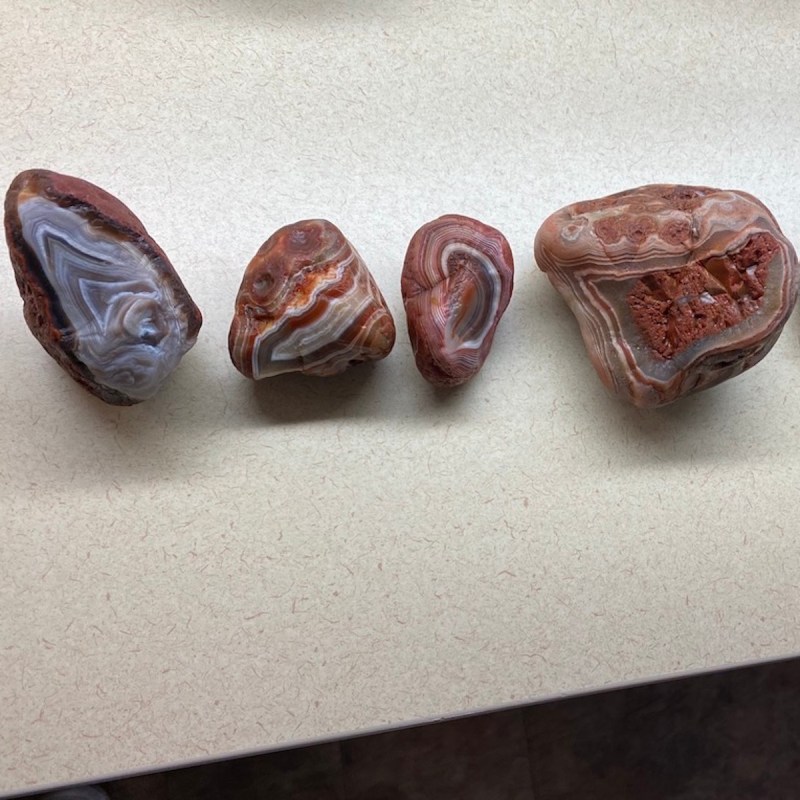
There aren’t many places in the United States where you can find semi-precious stones while on your daily walk. But if you live between Lake Superior and the Brainerd Lakes region in Minnesota, you have a chance to find agates.
Videos by TravelAwaits
More than a billion years ago, geologists hypothesized that molten lava spewed through the midcontinent rift, an enormous crack in the middle of North America stretching 2,000 miles from Lake Superior to Kansas. The lava layered onto the land and as it cooled, millions of air bubbles formed. As time passed, hot water percolated into these lava air bubble pockets; water that, in this part of the world, contained iron and silica. That combination created a mineral called chalcedony, a kind of quartz. And because of the iron in the region, the chalcedony here comes in shades of red, orange, and yellow. The deposits also created colorful bands and patterns within the rocks, prized in these Lake Superior agates.
Designated the state of Minnesota’s gemstone in 1969, agate hounds of all ages get excited when they find a Lake Superior agate. Its extrinsic value is based on weight, rarity, clarity, intensity of color, shape (including the absence of fissures or cracks), and whether or not it contains quartz, including amethyst.
The intrinsic value remains in the eye of the beholder. For me, I enjoyed the treasure hunt as a chance to pick up something of value. And going out with new friends into a different environment and learning about something I’d never heard of before.
Here are my tips for finding agates:

1. Know What You’re Looking For
Russ Clarke, RN, taught me what to look for, speaking to the “waxy luster” that helps you determine what is an agate and what is not. It’s humbling to have an 8-year-old (Russ’s daughter) stand over a section of stones and point saying, “It’s right there,” but still not be able to see it. When she bent over to pick it up, I had my first practical lesson in what to look for.
Your eyes cannot see what your brain does not know.
But once your brain knows what to look for, you get better. If you’re in the right area, you’ll find it. So I eventually went back to the quarry on my own and found a lot of (admittedly small) agates because I finally knew what to look for.
Agate hunters rely on the color, size, and most importantly, that luster.
Start by looking for small rocks that are red or orange. It surprised me to learn it’s easier to spot little agates since they’re more common. So look for small rocks. Most agates weigh just a few ounces.
Then look for rocks with uneven surfaces, especially with tiny holes on the outside. Agates are commonly pitted and rough to the touch.
When you turn the agate over, you’ll delight in the bands or waves. Carry a small bucket of water since the color enhances when wet.
If the rock has already been broken, you may be able to see layers inside, similar to a sliced onion.
Hold it up to the sunlight, though, and magic can happen. You might be able to see through some layers. In the sunlight, it may even look clear through sections. That’s especially exciting when I started finding them on my own.
As you become more familiar with Lake Superior agates, either by personal research, learning from friends, or classes with local professionals, you may learn about the variety of agates. These varieties add to the extrinsic monetary value and the intrinsic joy at finding a special rock. I found a Skip an Atom which Russ had only seen two or three times before. It looked like a small rock to me, yet he called it the “find of the day.”

Fortification agates are the most common type of agates. The bands look a lot like the rings of a sliced tree trunk.
The eye agate is pretty rare, but I still managed to find one, and a partial eye on another. This agate has a bullseye pattern to it. And it is really exciting to spot when you turn over a black rock (in my case) that more experienced agate hunters in the area might have just ignored because it wasn’t red.

2. Know Where To Look
Look where the agates are. Like Willie Sutton, the man who said he robbed banks “because that’s where the money is,” you have to know where to look.
Russ took us to a quarry near Brainerd to search for agates as I was learning. Then our families traveled together toward Lake Superior. The rocky shores on the north side of the lake are a popular place for agate hunters. Stores in Two Harbors sell maps where you’re likely to find agates. And they have books and classes to learn more.
Agates might be found on any quarry, dirt path, or farmer’s field in this region. Just make sure you ask for permission before entering private property. When my own garden was dug up to re-level the ground, I was out looking. Same when the downtown area broke its streets and re-paved. My shoes got sucked into very deep mud, but I found a handful of agates.
For anyone with physical limitations, the best place for you to look for agates would be on a dirt road. Because of the heavy snowfall in the region, the best time to look for agates is from April through early October.
3. Don’t Judge A Book By Its Cover
Chert is this awesome-looking stone that appears (to my now semi-trained eye) very similar to agates, especially at a distance of 4 or 5 feet. You have to pick it up and look for the luminescence before you can tell if a stone is a chert or if it’s an agate.
Even experts need to pick up a lot of stones with the classic deep red or orange of a Lake Superior agate.
Jasper is a very pretty rock that has a similar deep red as Lake Superior agates. It felt more brittle to me and often had bands of black running through it. But I had to wash off a fair amount of jasper to be sure it wasn’t a Lake Superior agate before throwing it back in the heap.
4. Have The Right Equipment
You need to have the right tools. You’ll find it easier to loosen the rock and surrounding dirt with a small rake or trowel. The rake worked better for me combing through large piles of stone. It’s very dusty work, so you’ll want to wear flexible gloves — garden gloves worked well. You’ll want to have a bucket, or at least a baggy to put your agates in, and a water bottle to help confirm it’s an agate, not chert. Since you’re in the country doing this, make sure you’re wearing good hiking shoes and watch out for snakes. Never stick your hand blindly into a crevice. As always, when working in the sun, keep plenty of drinking water and a few snack bars on hand.
5. Put Your Bucket On A Firm Foundation
One afternoon, I was out looking for agates with another neophyte agate hunter. We were chatting as we climbed a large mound of rocks, perhaps 12 feet high and 20 feet wide. I perched my water bucket filled with found agates on a divot near the top of the pile. With the rock shifting beneath and behind me, the bucket turned and spilled my earlier find down the opposite side of the pile. Yikes!
Lesson learned: Put your bucket on a firm foundation or risk your semi-precious stones falling down the same rock pile you just spent the past 3 hours pulling them from.
I was able to recollect many, but not all, of my agates. This taught me to be more mindful of precious (or semi-precious) items and to set a firmer foundation for my bucket before I moved on shifting surfaces.
Minnesota has a variety of different experiences for visitors:
